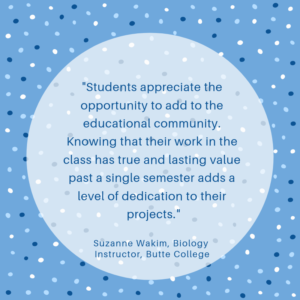“Effective teaching is inherently dynamic. Each time we teach a course, present a lecture, or engage our students in a learning activity, we teach when we respond to student questions and feedback “in the moment.” Effective teachers use experience to modify a lesson from semester to semester. Great online courses are not simply copied from semester to semester without significant changes, or allowed to run on autopilot, but rather are taught dynamically and improved with each iteration”. –@One
How does one teach “dynamically” online?
Teaching is an iterative process. As instructors, we strive to create an environment where learning engages our students and doesn’t let go. Dynamic instructors try new learning activities and introduce new learning objects in their classes and assess how it went. Through feedback in the form of discussion forum comments or questions received, or via summative assessments, instructors can determine whether something clicked (or didn’t) with students. Dynamic teaching is the act of reviewing those moments and replicating the successful content in other segments of the course; tweaking the parts that didn’t work too well in order to make the content a better online experience for learning; or trashing the activity altogether and starting anew. Having your pulse on your students’ understanding and interaction with the content and then taking action is the core of dynamic teaching.
Dynamic Teaching: Some Examples
Teach with short, engaging videos tied to an assessment
![Quotation from Columbia Univ. School of Education student: The most engaging videos for me [are] when the professors use wit and humor.](https://infoeduc8r.com/wp-content/uploads/2019/03/The-most-engaging-videos-for-me-are-when-the-professors-use-wit-and-humor._-300x300.png) The School of Continuing Education at Columbia University examined the analytics from its video hosting platform and recruited 10 students to participate in in-depth interviews about their learning experiences with course media. Videos with the highest number of views were tied to an assessment. These videos were also on average four minutes long and were accompanied by the instructor’s voice or appearance speaking in a conversational tone (Hibbert, 2014). In another study, Guo, Kim and Rubin (2014) recommended instructors produce videos with a more personal feel over a highly polished production. The authors also call for videos where an interspersed talking head appears at opportune times to create a more engaging presence (p. 2). Helen Graves, of @One created 4 Ways to Make Sure Students Are Watching Your Videos
The School of Continuing Education at Columbia University examined the analytics from its video hosting platform and recruited 10 students to participate in in-depth interviews about their learning experiences with course media. Videos with the highest number of views were tied to an assessment. These videos were also on average four minutes long and were accompanied by the instructor’s voice or appearance speaking in a conversational tone (Hibbert, 2014). In another study, Guo, Kim and Rubin (2014) recommended instructors produce videos with a more personal feel over a highly polished production. The authors also call for videos where an interspersed talking head appears at opportune times to create a more engaging presence (p. 2). Helen Graves, of @One created 4 Ways to Make Sure Students Are Watching Your Videos
Here’s one I created to introduce a module to my class. OK, I still need a little practice, but I’m a work in progress (aren’t we all?). Fast forward to minute 2:10 to see my attempt at humor. In the future, I will be creating screencasting videos with an assessment at the completion.
Incorporate student-driven discussions
One example might be to poll students on a particular module in the class. What resonates with them? By polling them, they are empowered in the decision-making process. From there, be the guide on the side and monitor the discussion that takes place. It is an opportunity to build a sense of community among learners while they engage with other students’ perspectives on the topic. This kind if interaction meets the “Development of a Learning Community” criteria (B.2) of the CVC-OEI Course Rubric.
Another example that speaks to the “Communication Strategies” criteria (B.1) of the CVC-OEI Course Rubric is having students engage in microlearning using social media. Microlearning refers to any pedagogy that encourages learning in short segments, and it can be supported through many platforms. (Trowbridge, Waterbury & Sudbury, 2017). Using Twitter as an example, an instructor can create a hashtag that the entire class can use. Students can comment on topics in class, share what they found in their research and how this new information may further their understanding of a topic. Social microlearning is a communication activity where interactions happen in a “rapid response” fashion whereby students gain practice communicating their knowledge–giving them confidence that their voice is part of the scholarly conversation. For instructors who may be hesitant to employ social media in the classroom, @One reviews how to create a safe experience with your students in their Teaching with Twitter Guide.
Respond to student feedback
When I started teaching online, I received poor feedback from some of my students. These students were frustrated because they couldn’t make the connection between the weekly assignments and how these were building blocks to the final project. Each week some students would submit an assignment based on a completely different topic than the one they chose to investigate at the beginning of the course. The instructions were to find one topic to research throughout the course, but this was not happening. I was totally flummoxed as to why many in the class “didn’t get it”. I tried to be very explicit in my directions but somewhere in the delivery I was not clear. I was having the same problem in my face-to-face classes but I could easily witness the confusion and quickly respond within the classroom.
One day I met with one of my face-to-face students who was having trouble ![]() with the assignments. After meeting with her and asking her about her confusion, we sat and talked and she finally said, “if you could give us an example of what it should look like, that would help.” I remember practically falling off my chair at her brilliance and my cluelessness!
with the assignments. After meeting with her and asking her about her confusion, we sat and talked and she finally said, “if you could give us an example of what it should look like, that would help.” I remember practically falling off my chair at her brilliance and my cluelessness!
I now post past examples of exemplary student work (with their permission) as models for each of the assignments. I then added a very quick 30 second to 1 minute video for each assignment, breaking down the points and clarifying any possible confusion. I went from about 50% of students understanding the assignments to 95% when I added the examples.
Have students generate content
Give students a vested interest in your class.  Have them create some of the test questions on a summative assessment, or submit content for your open access remixed textbook! Suzanne Wakim of Butte College initiated a Biology textbook where students add to the content of the textbook every semester. In this example, students realize they are not creating “throw-away” assignments and are more invested in their learning. Other instructors (Pacansky-Brock and others) have created Wisdom Walls where students who just completed a class share their experiences with those just starting out. It is a way to reduce anxiety for the new students and build relationships
Have them create some of the test questions on a summative assessment, or submit content for your open access remixed textbook! Suzanne Wakim of Butte College initiated a Biology textbook where students add to the content of the textbook every semester. In this example, students realize they are not creating “throw-away” assignments and are more invested in their learning. Other instructors (Pacansky-Brock and others) have created Wisdom Walls where students who just completed a class share their experiences with those just starting out. It is a way to reduce anxiety for the new students and build relationships
Next step: Continuous improvement of our teaching
To make meaningful, productive changes, we need a method for assessing what worked and what didn’t. Some of the tools we can use to assess this are:
- Canvas course analytics
- direct feedback from students
- indirect feedback from students
- self-reflection and peer interaction
(from @One’s Dynamic Teaching and Learning course)
In my department, we use a combination of all four of these tools. My favorite is self-reflection and peer interaction. At the end of every year, instructors for Library 4 get together off-campus for lunch and a debriefing session. We bring the feedback surveys that we collected from our students and discuss our successes and challenges. From there, we tweak some pieces and brainstorm on other potential dynamic learning activities. We utilize the Canvas sandbox to share our new content and get feedback. Then, we divvy up the new activities and try them out on our classes. We report back at the end of the semester on what happened and we might try another iteration the next semester.
Reflections
Where I was
In need of a dynamic infusion. As far as dynamic teaching, I had a few  embedded videos that I linked to, but nothing I ever created myself. My discussion forums were all instructor led with little student – student interaction. Even though I regularly tried new learning activities, I rarely asked for feedback — I only went with my gut feeling as to whether or not it worked.
embedded videos that I linked to, but nothing I ever created myself. My discussion forums were all instructor led with little student – student interaction. Even though I regularly tried new learning activities, I rarely asked for feedback — I only went with my gut feeling as to whether or not it worked.
Where I am
Budding videographer. I’ve started on creating video intros for every Canvas module  and I’m in the process of creating screen-casting content with my floating head appearing every now and then. I’m using Camtasia and am attempting to utilize some of the unique tools to call out important information.
and I’m in the process of creating screen-casting content with my floating head appearing every now and then. I’m using Camtasia and am attempting to utilize some of the unique tools to call out important information.
Where I am headed
Community builder. I’d like to build more of a learning community within my class. I am using the Peralta Community College  District’s Online Equity Rubric for guidance. For the “personal connections with and among students” criterion, the Aligned measure is, “At least 3 course activities require students to interact with each other in ways that value diverse student experiences and perspectives”. In Zaretta Hammond’s Culturally Responsive Teaching and The Brain, there is a table on how to use trust generators to build rapport with students (p. 79). These trust generators are: Selective Vulnerability, Familiarity, Similarity of Interests, Concern and Competence. Even though these are ways for instructors to build rapport with students, can they also be used to build rapport and connection between students?
District’s Online Equity Rubric for guidance. For the “personal connections with and among students” criterion, the Aligned measure is, “At least 3 course activities require students to interact with each other in ways that value diverse student experiences and perspectives”. In Zaretta Hammond’s Culturally Responsive Teaching and The Brain, there is a table on how to use trust generators to build rapport with students (p. 79). These trust generators are: Selective Vulnerability, Familiarity, Similarity of Interests, Concern and Competence. Even though these are ways for instructors to build rapport with students, can they also be used to build rapport and connection between students?
References and Attributions
Header image: “3. Dynamic Teaching” by Maryanne Mills is in the Public Domain, CC0
Image: “Lightbulb” by Maxim Kulikov, The Noun Project is licensed under CC BY-SA 3.0
California Community Colleges. (2020, April). Course design rubric. Retrieved from https://onlinenetworkofeducators.org/course-design-academy/online-course-rubric/
Graves, H. (2019, June 6). 4 ways to make sure students are watching your videos. @One Online Network of Educators. Retrieved from https://onlinenetworkofeducators.org/2019/06/06/4-ways-to-make-sure-students-are-watching-your-videos/
Guo, P.J., Kim, J. & Rubin. R. (2014). How video production affects student engagement: An empirical study of MOOC videos. SIGCHI Conference Proceedings. Retrieved from http://up.csail.mit.edu/other-pubs/las2014-pguo-engagement.pdf
Hammond, Z. (2015). Culturally responsive teaching & the brain. Thousand Oaks, CA: Corwin.
Hibbert, M. (2014, April 7). “What makes an online instructional video compelling?” Educause Review. Retrieved from https://er.educause.edu/articles/2014/4/what-makes-an-online-instructional-video-compelling
Peralta Community College District. (2021, March 14). Online Equity Rubric. Retrieved from https://web.peralta.edu/de/equity-initiative/equity/
Online Network of Educators. (n.d.). Tips for teaching with Twitter. Retrieved from https://onlinenetworkofeducators.org/cccdlday19/tips-for-teaching-with-twitter/
Trowbridge, S., Waterbury, C. & Sudbury, L. (2017, April 10). Learning in bursts: Microlearning with social media. Educause Review. Retrieved from https://er.educause.edu/articles/2017/4/learning-in-bursts-microlearning-with-social-media
Wakim, S. (n.d.). Welcome to biology. Retrieved from https://sites.google.com/site/buttebiology/home

